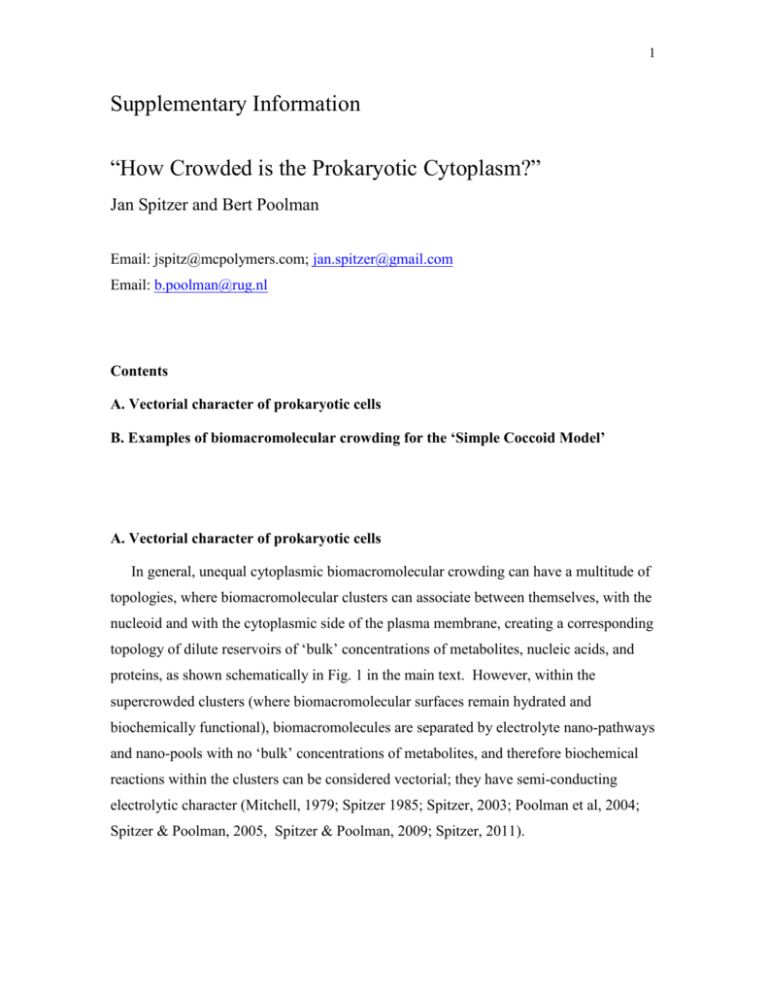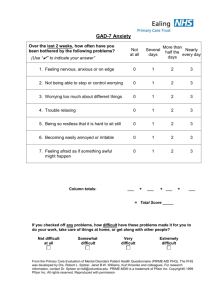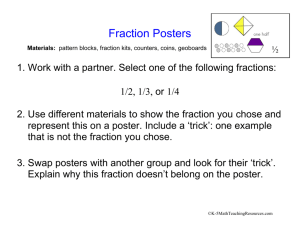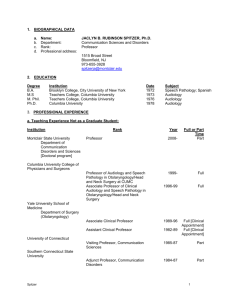feb2s0014579313004183-sup-mmc1
advertisement

1 Supplementary Information “How Crowded is the Prokaryotic Cytoplasm?” Jan Spitzer and Bert Poolman Email: jspitz@mcpolymers.com; jan.spitzer@gmail.com Email: b.poolman@rug.nl Contents A. Vectorial character of prokaryotic cells B. Examples of biomacromolecular crowding for the ‘Simple Coccoid Model’ A. Vectorial character of prokaryotic cells In general, unequal cytoplasmic biomacromolecular crowding can have a multitude of topologies, where biomacromolecular clusters can associate between themselves, with the nucleoid and with the cytoplasmic side of the plasma membrane, creating a corresponding topology of dilute reservoirs of ‘bulk’ concentrations of metabolites, nucleic acids, and proteins, as shown schematically in Fig. 1 in the main text. However, within the supercrowded clusters (where biomacromolecular surfaces remain hydrated and biochemically functional), biomacromolecules are separated by electrolyte nano-pathways and nano-pools with no ‘bulk’ concentrations of metabolites, and therefore biochemical reactions within the clusters can be considered vectorial; they have semi-conducting electrolytic character (Mitchell, 1979; Spitzer 1985; Spitzer, 2003; Poolman et al, 2004; Spitzer & Poolman, 2005, Spitzer & Poolman, 2009; Spitzer, 2011). 2 B. Examples of biomacromolecular crowding for the ‘Simple Coccoid Model’ Elaborating the simple coccoid model (Fig. 2 in the main article), Table 1 contains calculations of the thickness of the submembrane gel layer over a wide range of cytogel supercrowding and cytosol ‘dilutions’ according to eq. 2 in the main text. Cytogel ‘supercrowding’ [%] Cytosol ‘dilution’ [%] 0% 5% 10% 15% 20% 25 200 200 200 200 200 27 175 162 149 120 170 31 142 120 101 68 133 35 120 95 76 48 109 40 101 76 59 35 90 45 87 64 48 28 76 52 73 63 52 38 21 65 56 39 28 15 48 74 49 41 33 23 12 85 42 28 19 10 35 95 37 24 17 9 31 100 35 23 16 8 29 Suppl. Info. Table 1. Thickness (nm) of submembrane gel layer in a simple coccoid model. The data cover wide ranges of unequal crowding within the cytoplasm at constant (random) crowding of 25% volume fraction of biomacromolecules. The highlighted conditions at 52% crowding correspond to Fig. 2 in the main text. The highlighted (bold) data in the column with 5% dilute cytosol correspond to the specific example shown in Fig. 2 of the main article. The 52% volume packing is the lowest structural packing of spheres (simple cubic), and the 74% volume packing is the highest (hexagonal) density packing attainable without the spheres becoming deformed; in these ranges of supercrowding, vectorial biochemistry becomes operational because there is not enough space for metabolites to attain ‘bulk’ compositions (chemical potentials) independent of position. Under these ‘vectorial’ conditions, the thickness of the submembrane gel decreases from 63 nm at 52% supercrowding to 41 nm, at 74% supercrowding; in the extreme case of ‘dry’ cytogel (100% volume fraction of dry matter) the cytogel thickness shrinks to 29 nm, while the cytosol thickness expands to 170 nm, with still reasonable (from a chemical engineering point of view) ratios of volumes: 22% 3 for the nucleoid, 62% for the cytosol, and 16% for the ‘dry’ cytogel. Such high ranges of submembrane supercrowding conditions represent a physiological mechanism to protect the interior of the cell – the nucleoid – from adverse environmental conditions, i.e. from desiccation, while triggering new genetic and metabolic responses. In the range of 0% -20% volume fractions of ‘dilute’ cytosol, the thickness of the supercrowded cytogel changes only from about 70 nm to about 20 nm above the 52% volume fraction of cytogel supercrowding, i.e. by no more than about 3 ‘ribosomal’ diameters (the cases with the thickness of less than 20nm in the last two columns of Table 1 reflect the effect of already very crowded cytosol). 200 180 Thickness of the cytogel (nm) 160 Random Vectorial 140 120 Phase-inversion and interpenetrating networks 100 80 60 40 20 0 0.25 0.50 0.75 1.00 Degree of cytogel supercrowding at 0-20% crowding of cytosol 0% 5% 10% 15% 20% Suppl. Info. Fig 1. The onset of transient vectorial structures (biomacromolecular super-clusters) above 52% volume fraction crowding as described in the text. The data in Table 1 are represented in Suppl. Info Fig. 1; the plot starts at 25% average random crowding with no cytogel-cytosol boundary and a cytoplasmic shell 200 nm thick (first line in Table 1). As the cytogel gets supercrowded, a cytogel/cytosol boundary appears for any given level of cytosol ‘dilution’. Importantly, the cytogel thickness 4 decreases relatively fast and begins to level out above ~ 52% of cytogel supercrowding. In the ‘lower range’ of supercrowding (25% - 52% volume fraction), the cytogel structuring is weak and hence not very persistent; above the 52% volume fraction (52% - 100% volume fraction), the biomacromolecular clusters become more persistent and hence mechanically and physiologically more significant. An important reference point in this range is 74% volume fraction, corresponding to the closest packing of hard spheres; above the 74% volume fraction, the probability of deformation of protein tertiary structures increases, as well as the probability of a large-scale ‘phase inversion’ leading to a mechanically stronger system of ‘functionally agglomerated’ proteins and nucleic acids with interpenetrating aqueous channels through which electrolyte and metabolites can percolate. Similar conclusion has been reached (Fu et al, 2010) from the data obtained by photoactivated localization microscopy (PALM). Alternatively, in this highly crowded range, ‘pure proteins’ may separate, crystallize, and fuse (either physically, or via regulated biochemical cross-linking reactions) into mechanically strong structures. Supplementary Information References Fu G, Huang T, Buss J, Coltharp C, Hensel Z, Xiao J (2010) In vivo structure of the E. coli FtsZ-ring revealed by photoactivated localization microscopy (PALM). PLoS One; 5(9):e12682. Mitchell P (1979) Compartmentation and communication in living systems. Ligand conduction: a general catalytic principle in chemical, osmotic, and chemiosmotic reaction systems. Eur. J. Biochem. 95:1-20. Spitzer JJ (1984) A re-interpretation of hydration forces near charged surfaces. Nature 310:396-397. Spitzer JJ (2003) Maxwellian Double Layer Forces: from Infinity to Contact. Langmuir 19:7099-7111. Poolman B, Spitzer JJ, and Wood JM (2004) Bacterial osmosensing: roles of membrane structure and electrostatics in lipid–protein and protein–protein interactions. 5 Spitzer JJ and Poolman B (2005) Electrochemical structure of the crowded cytoplasm. Trends Biochem. Sci. 30:536-541. Spitzer JJ and Poolman B (2009) The role of biomacromolecular crowding, ionic strength and physicochemical gradients in the complexities of life’s emergence. Microbiol. Mol. Biol. Rev. 73:371-388. Spitzer J (2011) From water and ions to crowded biomacromolecules: in vivo structuring of a prokaryotic cell. Microbiol. Mol. Biol. Rev. 75:491-506.





